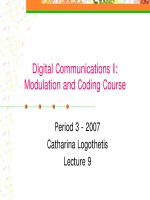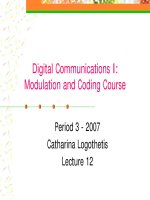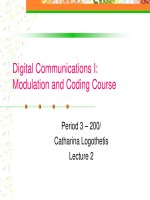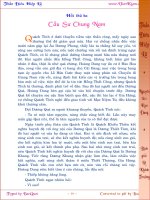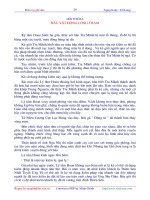Tài liệu Modulation and coding course- lecture 3 pptx
Bạn đang xem bản rút gọn của tài liệu. Xem và tải ngay bản đầy đủ của tài liệu tại đây (177.95 KB, 22 trang )
Digital Communication I:
Modulation and Coding Course
Period 3 - 2007
Catharina Logothetis
Lecture 3
Lecture 3 2
Last time we talked about:
Transforming the information source to a form
compatible with a digital system
Sampling
Aliasing
Quantization
Uniform and non-uniform
Baseband modulation
Binary pulse modulation
M-ary pulse modulation
M-PAM (M-ay Pulse amplitude modulation)
Lecture 3 3
Formatting and transmission of baseband signal
Information (data) rate:
Symbol rate :
For real time transmission:
Sampling at rate
(sampling time=Ts)
Quantizing each sampled
value to one of the
L levels in quantizer.
Encoding each q. value to
bits
(Data bit duration Tb=Ts/l)
Encode
Pulse
modulate
Sample Quantize
Pulse waveforms
(baseband signals)
Bit stream
(Data bits)
Format
Digital info.
Textual
info.
Analog
info.
source
Mapping every data bits to a
symbol out of M symbols and transmitting
a baseband waveform with duration T
ss
Tf /1=
Ll
2
log
=
Mm
2
log
=
[bits/sec] /1
bb
TR
=
ec][symbols/s /1 TR
=
mRR
b
=
Lecture 3 4
Quantization example
t
Ts: sampling time
x(nTs): sampled values
xq(nTs): quantized values
boundaries
Quant. levels
111 3.1867
110 2.2762
101 1.3657
100 0.4552
011 -0.4552
010 -1.3657
001 -2.2762
000 -3.1867
PCM
codeword
110 110 111 110 100 010 011 100 100 011
PCM sequence
amplitude
x(t)
Lecture 3 5
Example of M-ary PAM
-B
B
T
‘01’
3B
T
T
-3B
T
‘00’
‘10’
‘1’
A.
T
‘0’
T
-A.
Assuming real time tr. and equal energy per tr. data bit for
binary-PAM and 4-ary PAM:
• 4-ary: T=2Tb and Binay: T=Tb
•
4-ary PAM
(rectangular pulse)
Binary PAM
(rectangular pulse)
‘11’
22
10BA =
Lecture 3 6
Example of M-ary PAM …
0 Tb 2Tb 3Tb 4Tb 5Tb 6Tb
0 Ts 2Ts
0 T 2T 3T
2.2762 V 1.3657 V
1 1 0 1 0 1
0 T 2T 3T 4T 5T 6T
Rb=1/Tb=3/Ts
R=1/T=1/Tb=3/Ts
Rb=1/Tb=3/Ts
R=1/T=1/2Tb=3/2Ts=1.5/Ts
Lecture 3 7
Today we are going to talk about:
Receiver structure
Demodulation (and sampling)
Detection
First step for designing the receiver
Matched filter receiver
Correlator receiver
Lecture 3 8
Demodulation and detection
Major sources of errors:
Thermal noise (AWGN)
disturbs the signal in an additive fashion (Additive)
has flat spectral density for all frequencies of interest (White)
is modeled by Gaussian random process (Gaussian Noise)
Inter-Symbol Interference (ISI)
Due to the filtering effect of transmitter, channel and receiver,
symbols are “smeared”.
Format
Pulse
modulate
Bandpass
modulate
Format Detect
Demod.
& sample
)(ts
i
)(tg
i
i
m
i
m
ˆ
)(tr)(Tz
channel
)(th
c
)(tn
transmitted symbol
estimated symbol
Mi ,,1 K
=
M-ary modulation
Lecture 3 9
Example: Impact of the channel
Lecture 3 10
Example: Channel impact …
)75.0(5.0)()( Tttth
c
−−=
δ
δ
Lecture 3 11
Receiver job
Demodulation and sampling:
Waveform recovery and preparing the received
signal for detection:
Improving the signal power to the noise power (SNR)
using matched filter
Reducing ISI using equalizer
Sampling the recovered waveform
Detection:
Estimate the transmitted symbol based on the
received sample
Lecture 3 12
Receiver structure
Frequency
down-conversion
Receiving
filter
Equalizing
filter
Threshold
comparison
For bandpass signals
Compensation for
channel induced ISI
Baseband pulse
(possibly distored)
Sample
(test statistic)
Baseband pulse
Received waveform
Step 1 – waveform to sample transformation
Step 2 – decision making
)(tr
)(Tz
i
m
ˆ
Demodulate & Sample Detect
Lecture 3 13
Baseband and bandpass
Bandpass model of detection process is
equivalent to baseband model because:
The received bandpass waveform is first
transformed to a baseband waveform.
Equivalence theorem:
Performing bandpass linear signal processing followed by
heterodying the signal to the baseband, yields the same
results as heterodying the bandpass signal to the
baseband , followed by a baseband linear signal
processing.
Lecture 3 14
Steps in designing the receiver
Find optimum solution for receiver design with the
following goals:
1. Maximize SNR
2. Minimize ISI
Steps in design:
Model the received signal
Find separate solutions for each of the goals.
First, we focus on designing a receiver which
maximizes the SNR.
Lecture 3 15
Design the receiver filter to maximize the SNR
Model the received signal
Simplify the model:
Received signal in AWGN
)(th
c
)(ts
i
)(tn
)(tr
)(tn
)(tr
)(ts
i
Ideal channels
)()( tth
c
δ
=
AWGN
AWGN
)()()()( tnthtstr
ci
+
∗
=
)()()( tntstr
i
+
=
Lecture 3 16
Matched filter receiver
Problem:
Design the receiver filter such that the SNR is
maximized at the sampling time
when
is transmitted.
Solution:
The optimum filter, is the Matched filter, given by
which is the time-reversed and delayed version of the conjugate
of the transmitted signal
)(th
)()()(
*
tTsthth
iopt
−==
)2exp()()()(
*
fTjfSfHfH
iopt
π
−==
Mits
i
, ,1 ),(
=
T0t
)(ts
i
T0t
)()( thth
opt
=
Lecture 3 17
Example of matched filter
Tt Tt Tt
02T
)()()( thtsty
opti
∗
=
2
A
)(ts
i
)(th
opt
Tt Tt Tt
02T
)()()( thtsty
opti
∗
=
2
A
)(ts
i
)(th
opt
T/2 3T/2
T/2 TT/2
2
2
A
−
T
A
T
A
T
A
T
A−
T
A−
T
A
Lecture 3 18
Properties of the matched filter
The Fourier transform of a matched filter output with the matched signal as
input is, except for a time delay factor, proportional to the ESD
of the input
signal.
1. The output signal of a matched filter is proportional to a shifted version of
the autocorrelation function of the input signal to which the filter is matched.
The output SNR of a matched filter depends only on the ratio of the signal
energy to the PSD of the white noise at the filter input
.
1. Two matching conditions in the matched-filtering operation:
spectral phase matching that gives the desired output peak at time T.
spectral amplitude matching that gives optimum SNR to the peak value.
)2exp(|)(|)(
2
fTjfSfZ
π
−=
sss
ERTzTtRtz
=
=
⇒
−
=
)0()()()(
2/
max
0
N
E
N
S
s
T
=
⎟
⎠
⎞
⎜
⎝
⎛
Lecture 3 19
Correlator receiver
The matched filter output at the sampling time,
can be realized as the correlator output.
>=<=
∗
=
∫
)(),()()(
)()()(
*
0
tstrdsr
TrThTz
i
T
opt
τττ
Lecture 3 20
Implementation of matched filter receiver
⎥
⎥
⎥
⎦
⎤
⎢
⎢
⎢
⎣
⎡
M
z
z
M
1
z=
)(tr
)(
1
Tz
)(
*
1
tTs −
)(
*
tTs
M
−
)(Tz
M
z
Matched filter output:
Observation
vector
Bank of M matched filters
)()( tTstrz
i
i
−∗=
∗
Mi , ,1
=
), ,,())(), ,(),((
2121 MM
zzzTzTzTz
=
=z
Lecture 3 21
Implementation of correlator receiver
dttstrz
i
T
i
)()(
0
∫
=
∫
T
0
)(
1
ts
∗
∫
T
0
)(ts
M
∗
⎥
⎥
⎥
⎦
⎤
⎢
⎢
⎢
⎣
⎡
M
z
z
M
1
z=
)(tr
)(
1
Tz
)(Tz
M
z
Correlators output:
Observation
vector
Bank of M correlators
), ,,())(), ,(),((
2121 MM
zzzTzTzTz
=
=z
Mi , ,1
=
Lecture 3 22
Implementation example of matched filter
receivers
⎥
⎥
⎥
⎦
⎤
⎢
⎢
⎢
⎣
⎡
2
1
z
z
z
=
)(tr
)(
1
Tz
)(
2
Tz
z
Bank of 2 matched filters
Tt
)(
1
ts
Tt
)(
2
ts
T
T
0
0
T
A
T
A−
T
A−
T
A
0
0


